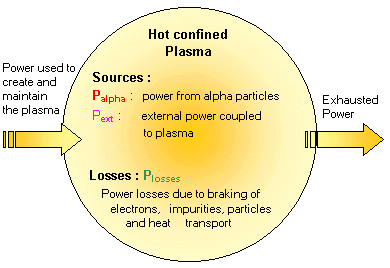|
2) Energy balance and Lawson criterion
(p 1
- 2
)
|
How can we
trigger multiple fusion reactions ? It is necessary to confine effectively enough a sufficiently dense and hot plasma. Why? Here are the explanations
|
a) Pasma power balance As in the example of a cauldron, the
plasma energy balance is determined by the energy sources feeding the plasma and the energy losses
cooling it down. For the plasma to remain stationary (i.e. not changing over
time), the energy balance must be in equilibrium, i.e. the sources must compensate the losses.  Energy sources : Pfusion and Pexternal
Energy sources : Pfusion and Pexternal
|
Fusion power : Pfusion
:
The total power produced by the
D-T fusion reaction Pfusion is divided between the products of the
reaction, the alpha particles, i.e. the helium nuclei (He), and the neutrons. This
gives:
Pfusion
= Palpha
+ Pneut |

|
|
The neutrons take away about 80% of the
energy, while the heavier alpha particles, keep about 20%. But this energy does not end up in the same place :
-
Palpha : the main source of the plasma energy comes from
the alpha particles. Indeed, these charged particles are confined by the tokamak
magnetic field, and give their energy to the
plasma by collision.
-
Pneut : in contrast, the neutrons (n) from the fusion reaction are not sensitive to the magnetic field,
since they have no charge, and thus escape quickly, without having time to give their energy to the plasma. They are stopped by the materials in the components surrounding the tokamak vacuum chamber.
|
External power Pexternal
:
If the energy from the fusion reactions is not sufficient to compensate losses, it is necessary to supply energy from the outside to maintain the plasma using an additional heating system. This is the external power Pexternal.
 Energy losses: Plosses
Energy losses: Plosses
-
The plasma confinement by the magnetic field is not perfect: particles and heat
diffuse from the plasma center towards the outside. The losses connected to this particles and
heat transport are considerable.
-
As a hot body, the plasma also cools by radiation according to different processes. The electrons emit
continuous radiation in their collisions with ions ("Bremsstrahlung"). They also emit synchrotron radiation
due to their gyration movement around field lines, which may grow considerably when the plasma is heated up to a very high temperature. Finally, the impurities emitted by the wall surrounding the vacuum chamber produce
line radiation due to the different atomic physic processes which have taken place in the plasma. This
contribution may become very important if the plasma is strongly polluted and may even lead to an abrupt loss of plasma confinement: this is known as
a disruption.
The result of all these terms gives the total power lost by the plasma Plosses.
 The balance
The balance
The temporal variation of the
plasma energy W may thus be written as :
dW/dt
= Palpha
+ Pexternal -
Plosses
|
Reminder: only the alpha particles give their energy to the plasma, the rest of the fusion power is dissipated into the components surrounding the plasma. If the source term is higher than the loss term (dW/dt >0), the plasma gains
energy;in the opposite case (dW/dt <0), it loses it. If the sources precisely compensate the losses (dW/dt =0), the plasma is
stationary. Several useful quantities may now be defined. |

|
|
This is the characteristic time of
decrease in plasma energy; in other words, it is the time taken by the plasma to empty itself of its energy content if the sources supplying it are abruptly cut off.
Thus:
W/ tE=
Plosses
NB : this time has nothing to do with the pulse duration, which is determined by the capacities of the machine magnetic system or plasma
instabilities. For example, on Tore Supra, the energy confinement time is around 200 milliseconds (or 0,2 seconds) while the pulses last
tens of seconds and even minutes |
|
This is the ratio between the power from fusion reactions and the external power supplied to the plasma by the heating systems: Q
= Pfusion
/ Pexternal This figure thus qualifies the plasma’s energy balance. If it is higher than 1, more energy has been produced with fusion reactions than was necessary to supply to maintain the plasma.
NB : the Q factor must not be confused with the overall
efficiency of the installation. |
|
This is the situation corresponding to Q = 1, i.e. the moment when the quantity of energy produced by the fusion reactions is equal to that supplied to maintain the plasma ( Pfusion=
Pexternal) . This is an interesting stage from the scientific point of view, as heating of the plasma is then to a great extent done by the alpha particles and no longer nearly solely by the additional heating, which is close to the situation of the reactor. |
| |
This is the situation where the power supplied by the fusion reactions is enough on its own to compensate losses ( Palpha=
Plosses) and where
the external power can thus be switched off. This corresponds to an infinite Q amplification factor ( Pexternal
= 0). The plasma is thus self-maintained like a candle, which, once it has been ignited by a match (external power), carries on fuelling itself. |

|
Most current experimental machines destined for research and not yet
for electricity production, operate at Q<1, i.e. the plasma consumes more energy than it supplies. They only use deuterium as a fuel, enabling the necessary physical studies without the use of radioactive
tritium; the results obtained in D-D fusion to D-T fusion
are then extrapolated. Only 2 machines have for the moment experimented with the use of tritium: the American machine TFTR, now closed, and the European machine JET, which holds the world record of fusion power in D-T, with 16 MegaWatts produced, corresponding to an amplification factor of 0.64.
|
|